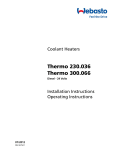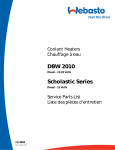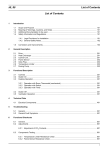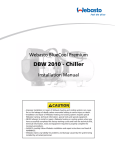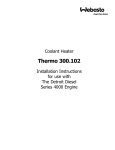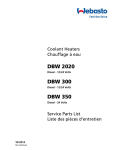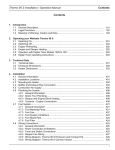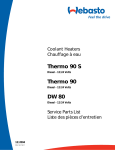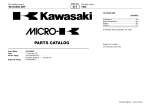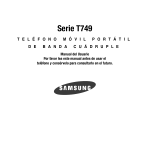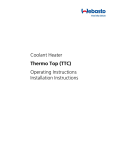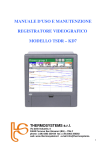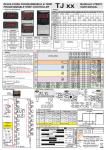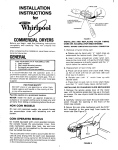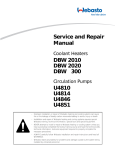Download Webasto Blue Bird Scholastic Series School Bus Heater Automobile Parts User Manual
Transcript
The Scholastic Series School Bus Heater Operating Instructions Installation Instructions Service Parts Listing For: Webasto Thermosystems Inc. North America 3333 John Conley Drive Lapeer, MI 48446 Phone (810) 245-2400 Toll-free (800) HEATER-1 Fax (810) 664-7720 Technical Assistance Hotline USA: (800) 555-4518 Canada: (800) 667-8900 Org. 2/2001 50000058A www.webasto.com Conventional Model Transit Model (Engine Front) Transit Model (Engine Rear) WEBASTO SCHOLASTIC SERIES TABLE OF CONTENTS . . . . . . . . . . . . Table of Contents 1. Introduction 1.1 1.2 1.3 1.4 Scope and Purpose . . . . . . . . . . . . . . . . . . . Meaning of Warnings, Cautions and Notes . Additional Documentation to be Used . . . . . General Safety Regulations and Information 1.4.1 2. . . . . . . . . . . . . . . . . . . . . . . . . . . . . . . . . . . . . . . . . . . . . . . . . . . . . . . . . . . . . . . . . . . . . . . . . . . . . . . . . . . . . . . . . . . . . . . . . . . . . . . . . . . . . 1-1 1-1 1-1 1-1 General Safety Notes . . . . . . . . . . . . . . . . . . . . . . . . . . . . . . . . . . . . . . . . . . . 1-1 Scholastic Heater Description . . . . . . . . . . . . . . . . . . . . . . . . . . . . . . . . . . . . . . . . . . . . 2-1 Operating your Webasto Scholastic Heater . . . . . . . . . . . . . Switching On . . . . . . . . . . . . . . . . . . . . . . . . . . . . . . . . . . . . Switching Off . . . . . . . . . . . . . . . . . . . . . . . . . . . . . . . . . . . . Engine Preheating . . . . . . . . . . . . . . . . . . . . . . . . . . . . . . . . Boost Heating for Engine and Passenger Compartment . . . . Operation with 7-Day Digital Timer Model 1531 . . . . . . . . . . 7-Day Digital Timer Programming and Operating Instructions . . . . . . . . . . . . . . . . . . . . . . . . . . . . . . . . . . . . . . . . . . . . . . . . . . . . . . . . . . . . . . . . . . . . . . . . . . . . . . . . . . . . . . . . . . . . . . . . . . . . . . . . . . . . . . . . . . . . . . . . . . . . . . . . . . . . . . . . . . . . . . . . . . . 3-1 3-1 3-2 3-2 3-2 3-2 3-4 Technical Data 4.1 Scholastic Series Heater Data . . . . . . . . . . . . . . . . . . . . . . . . . . . . . . . . . . . . . . . . . . . . 4-1 4.1.1 4.2 4.3 Scholastic Series Heater Dimensions . . . . . . . . . . . . . . . . . . . . . . . . . . . . . . . 4-2 Coolant Circulation Pump Data . . . . . . . . . . . . . . . . . . . . . . . . . . . . . . . . . . . . . . . . . . . 4-3 4.2.1 5. . . . . Functional Description 3.1 3.2 3.3 3.4 3.5 3.6 3.7 4. . . . . General Description 2.1 3. . . . . Coolant Circulation Pump Dimensions . . . . . . . . . . . . . . . . . . . . . . . . . . . . . . . 4-3 Tray Mount Dimensions . . . . . . . . . . . . . . . . . . . . . . . . . . . . . . . . . . . . . . . . . . . . . . . . . 4-4 Installation 5.1 5.2 5.3 5.4 5.5 5.6 General Information . . . . . . . . . . . Installation Locations . . . . . . . . . . Mounting the Heater . . . . . . . . . . Exhaust Pipe Connection . . . . . . Combustion Air Supply . . . . . . . . Plumbing into the Coolant System 5.6.1 5.6.2 5.6.3 . . . . . . . . . . . . . . . . . . . . . . . . . . . . . . . . . . . . . . . . . . . . . . . . . . . . . . . . . . . . . . . . . . . . . . . . . . . . . . . . . . . . . . . . . . . . . . . . . . . . . . . . . . . . . . . . . . . . . . . . . . . . . . . . . . . . . . . . . . . . . . . . . . . . . . . . . . . . . . . . . . . . . . . . . . . . . . . . . . . . . . . . . . . . . . . . . . . . . . . . . . . . . . . . . . . . . . . . . . . . . . . . . . . . . . . . . . . . . . . . . . . . . . 5-1 5-1 5-2 5-2 5-3 5-3 General Information . . . . . . . . . . . . . . . . . . . . . . . . . . . . . . . . . . . . . . . . . . . . . 5-3 Engine and Passenger Compartment Heating . . . . . . . . . . . . . . . . . . . . . . . . . 5-4 Instructions for Integrating into the Coolant System . . . . . . . . . . . . . . . . . . . . . 5-5 I TABLE 5.7 OF Fuel System . . . . . . . . . . . . . . . . . . . . . . . . . . . . . . . . . . . . . . . . . . . . . . . . . . . . . . . . . 5-7 5.7.1 5.7.2 5.7.3 5.8 6. . . . . . . . . . . . . . . . . . . . . . . . . . . . . 5-10 . 5-10 . 5-11 . 5-11 . 5-12 . 5-13 . 5-14 . 5-15 . 5-16 Initial Operation . . . . . . . . . . . . . . . . . . . . . . . . . . . . . . . . . . . . . . . . . . . . . . . . . . . . . . . 5-17 Annual Maintenance . . . . . . . . . . . . . . . . . . . . . . . . . . . . . . . . . . . . . . . . . . . . . . . . . . . 6-1 Basic Troubleshooting 7.1 7.2 7.3 7.4 8. General Information . . . . . . . . . . . . . . . . . . . . . . . . . . . . . . . . . . . . . . . . . Connecting Power Harness to a Constant Power Source . . . . . . . . . . . . . Timer and Switch Connections . . . . . . . . . . . . . . . . . . . . . . . . . . . . . . . . Timer and Switch Installation . . . . . . . . . . . . . . . . . . . . . . . . . . . . . . . . . . Wiring Diagram - Scholastic Series Heater . . . . . . . . . . . . . . . . . . . . . . . Wiring Diagram - Chassis / Power Harness with Switch . . . . . . . . . . . . . . Wiring Diagram - Chassis / Power Harness with Switch . . . . . . . . . . . . . . Wiring Diagram - Chassis / Power Harness with Digital Timer Model 1531 Wiring Diagram - Chassis / Power Harness with Digital Timer Model 1531 Maintenance of the Heater 6.1 7. General Description . . . . . . . . . . . . . . . . . . . . . . . . . . . . . . . . . . . . . . . . . . . . . 5-7 Fuel Supply . . . . . . . . . . . . . . . . . . . . . . . . . . . . . . . . . . . . . . . . . . . . . . . . . . . 5-7 Fuel Filter . . . . . . . . . . . . . . . . . . . . . . . . . . . . . . . . . . . . . . . . . . . . . . . . . . . . 5-9 Wiring Connections . . . . . . . . . . . . . . . . . . . . . . . . . . . . . . . . . . . . . . . . . . . . . . . . . . . . 5-10 5.8.1 5.8.2 5.8.3 5.8.4 5.8.5 5.8.6 5.8.7 5.8.8 5.8.9 5.9 WEBASTO SCHOLASTIC SERIES CONTENTS General Information . . . . . . . . . . . . . . . . Quick Check Troubleshooting Matrix . . . Heater Test Unit (Webasto P.N. 440280) Test Procedures . . . . . . . . . . . . . . . . . . . . . . . . . . . . . . . . . . . . . . . . . . . . . . . . . . . . . . . . . . . . . . . . . . . . . . . . . . . . . . . . . . . . . . . . . . . . . . . . . . . . . . . . . . . . . . . . . . . . . . . . . . . . . . . . . . . . . . . . . . . . . . . . . . . . . . . . . . . . . . . . . . 7-1 7-1 7-2 7-3 Spare Parts Listing Spare Parts Listing . . . . . . . . . . . . . . . . . . . . . . . . . . . . . . . . . . . . . . . . . . . . . . . . . . . . 8-1 II WEBASTO SCHOLASTIC SERIES TABLE OF CONTENTS . . . . . . . . . . . . . . . . . . . . . . . . . . . . . . . . . . . . . . . . . . . . . . . . . . . . . . . . . . . . . . . . . . . . . . . . . . . . . . . . . . . . . . . . . . . . . . . . . . . . . . . . . . . . . . . . . . . . . . . . . . . . . . . . . . . . . . . . . . . . . . . . . . . . . . . . . . . . . . . . . . . . . . . . . . . . . . . . . . . . . . . . . . . . . . . . . . . . . . . . . . . . . . . . . . . . . . . . . . . . . . . . . . . . . . . . . . . . . . . . . . . 2-1 . 3-3 . 4-2 . 4-3 . 4-4 . 5-1 . 5-2 . 5-3 . 5-4 . 5-4 . 5-5 . 5-7 . 5-8 . 5-10 . 5-11 . 5-11 . 5-12 . 5-13 . 5-14 . 5-15 . 5-16 . 7-2 . . . . . . . . . . . . . . . . . . . . . . . . . . . . . . . . . . . . . . . . . . . . . . . . . . . . . . . . . . . . List of Figures 2-1 3-1 4-1 4-2 4-3 5-1 5-2 5-3 5-4 5-5 5-6 5-7 5-8 5-9 5-10 5-11 5-12 5-13 5-14 5-15 5-16 7-1 Webasto Scholastic Series Heater . . . . . . . . . . . . . . . . . . . . . . . . . . . . . 7-Day Digital Timer – Typical . . . . . . . . . . . . . . . . . . . . . . . . . . . . . . . . . Scholastic Series Heater Dimensions (Millimeters) . . . . . . . . . . . . . . . . . Coolant Circulating Pump Assembly (P.N. 906017) Dimensions (Inches) Tray Mount Dimensions (Inches) . . . . . . . . . . . . . . . . . . . . . . . . . . . . . . Installation Locations . . . . . . . . . . . . . . . . . . . . . . . . . . . . . . . . . . . . . . . Tray Mount Template (Supplied with Heater Kit) . . . . . . . . . . . . . . . . . . . Typical School Bus Heating Circuit . . . . . . . . . . . . . . . . . . . . . . . . . . . . Series Plumbing Circuit - Conventional Model . . . . . . . . . . . . . . . . . . . . Series Plumbing Circuit - Transit Model (Engine Front) . . . . . . . . . . . . . Series Plumbing Circuit - Transit Model (Engine Rear) . . . . . . . . . . . . . . Fuel Standpipe Installation . . . . . . . . . . . . . . . . . . . . . . . . . . . . . . . . . . . Fuel Line Parameters . . . . . . . . . . . . . . . . . . . . . . . . . . . . . . . . . . . . . . Harness Connection Points . . . . . . . . . . . . . . . . . . . . . . . . . . . . . . . . . . On/Off Switch . . . . . . . . . . . . . . . . . . . . . . . . . . . . . . . . . . . . . . . . . . . . 7-Day Digital Timer Model 1531 . . . . . . . . . . . . . . . . . . . . . . . . . . . . . . . Wiring Diagram - Scholastic Series Heater . . . . . . . . . . . . . . . . . . . . . . Wiring Diagram with Switch . . . . . . . . . . . . . . . . . . . . . . . . . . . . . . . . . . Wiring Diagram with Switch . . . . . . . . . . . . . . . . . . . . . . . . . . . . . . . . . . Wiring Diagram with Timer Model 1531 . . . . . . . . . . . . . . . . . . . . . . . . . Wiring Diagram with Timer Model 1531 . . . . . . . . . . . . . . . . . . . . . . . . . Test Unit P.N. 440280 . . . . . . . . . . . . . . . . . . . . . . . . . . . . . . . . . . . . . . List of Tables 3-1 4-1 4-2 7-1 7-2 Digital Timer Instructions . . . . . . . . . Scholastic Series Heater Data . . . . . Coolant Circulation Pump Data . . . . Quick Check Troubleshooting Matrix Test Procedures and Results . . . . . . . . . . . . . . . . . . . . . . . . . . . . . . . . . . . . . . . . . . . . . . . . . . . . . . . . . . . . . . . . . . . . . . . . . . . . . . . . . . . . . . . . . . . . . . . . . . . . . . . . . . . . . . . . . . . . . . . . . . . . . . . . . . . . . . . . . . . . . 3-4 4-1 4-3 7-1 7-3 III WEBASTO SCHOLASTIC SERIES 1. Introduction 1.1 Scope and Purpose This manual is intended to support authorized Webasto trained distributors, dealers and personnel in the installation of the Scholastic Series coolant heater. Webasto Thermosystems, Inc. does not recommend the installation and servicing of Webasto products by untrained, unauthorized personnel or end-users. Installations and servicing of Webasto products by untrained, unauthorized personnel and end-users will release Webasto Thermosystems, Inc. and Webasto authorized distributors, dealers and personnel from responsibility for damage to Webasto product or collateral property and personal injury. Any use, operation, installation, modification or application of the product not described in Webasto manuals, or subjecting the product to extreme or unusual conditions beyond the limits of specified performance characteristics is misuse of the product. Failure to comply with all installation instructions is a misuse of Webasto product. The same applies for repairs without using genuine Webasto service parts. This will void the coolant heaters “Official Marks of Conformity.” 1.2 Meaning of Warnings, Cautions, and Notes Warnings, Cautions and Notes in this manual have the following meaning: WARNING This heading is used to highlight that non-compliance with instructions or procedures may cause injuries or lethal accidents to personnel. 1 1.3 INTRODUCTION Additional Documentation to be Used This manual contains all of the information and procedures necessary for the installation of the Scholastic Series heater. The use of additional documentation is normally not necessary. Vehicle specific installation guides (when available) may be used as complementary information if necessary. 1.4 General Safety Regulations and Information The general safety regulations for the prevention of accidents and relevant operating safety instructions must be observed at all times. The specific safety regulations applicable to this manual are highlighted in the individual chapters by Warnings, Cautions and Notes. 1.4.1 General Safety Notes The heater may only be installed in vehicles, with a minimum coolant capacity of 10 litres (2.6 US Gal.). The heater must not be installed in the passenger compartments of the vehicle. Should the heater be installed in such a compartment, the installation box must be sealed tight against the vehicle interior. There must be sufficient ventilation of the installation box from the exterior in order not to exceed a maximum temperature of 60 °C (140 °F) in the installation box. Excessive temperatures may cause malfunctions. WARNING Due to the danger of poisoning and suffocation, the heater must not be operated in enclosed areas, such as garages or workshops, without an exhaust venting system, not even if the start-up is activated by the timer or remote start device. CAUTION This heading is used to highlight that non-compliance with instructions or procedures may cause damage to equipment. At filling stations and fuel depots the heater must be switched off as there is a potential danger of explosions. NOTE: This heading is used to highlight and draw specific attention to information. Where flammable fumes or dust may build up (e.g. in the vicinity of fuel, coal, wood, cereal grain deposits or similar situations) the heater must be switched off to prevent explosions. 1-1 1 INTRODUCTION In the vicinity of the coolant heater, a temperature of 85 °C (185 °F) must not be exceeded under any circumstances (e.g. during body paint work). A violation of this temperature limit may cause permanent damage to the electronics. When checking the coolant level, proceed in accordance with the vehicle manufacturer’s instructions. The coolant in the heating circuit of the heater must contain a minimum of 10% of a quality brand glycol based anti-freeze. Extracting combustion air from the vehicle interior is not permissible under any circumstance. The exhaust line outlet is to be positioned below the vehicle floor, to the nearest possible location of the vehicle’s left side. Exhaust pipes must be routed so that exhaust fumes will not penetrate into the vehicle’s interior. The function of any parts vital for vehicle operation must not be impaired. Condensation accumulation in the exhaust line must be directly drained. A condensation drain hole may be provided as required. Electrical lines, switch gear, and control gear of the heater must be located in the vehicle so that their proper function cannot be impaired under normal operating conditions. The coolant heater may only be operated within the specified operating voltage range designated by type. 1-2 WEBASTO SCHOLASTIC SERIES The coolant heater may only be operated with the specified fuel (Diesel 1, Diesel 2, Arctic grade, Kerosene and certain military spec. fuels). For the routing of fuel lines, the following important regulations must be adhered to: • Fuel lines are to be installed in such a way that they remain unaffected by torsional stresses created by vehicle and engine movement. They must be protected against mechanical damage. Fuel lines must be securely fastened to the vehicle every 30 cm. (12 inches) or more often along the total length from heater to fuel tank. Fuel-carrying parts are to be protected against excessive heat and are to be installed so that any dripping or evaporating fuel can neither accumulate nor be ignited by hot components or electrical equipment. • In buses, fuel lines are not to be located in the passenger area or in the driver’s compartment. Fuel supply must not be by means of gravity or pressurization of the fuel tank. • The fuel tank must either be equipped with a vent cap or be ventilated in another way (ventilation line). • The operational state of the heater, i.e. an indication “On” or “Off”, must be clearly visible to the operator. WEBASTO SCHOLASTIC SERIES 2. General Description 2.1 Scholastic Heater Description 2 GENERAL DESCRIPTION Fig. 2-1: Webasto Scholastic Series Heater 1 2 3 4 5 6 7 8 9 Electronic control unit Motor Electronic ignition coil Coupler Combustion air fan Solenoid valve Electrode holder Outlet water pipe - 25 mm (1 in. OD.) Inlet water pipe - 25 mm (1 in. OD.) 10 11 12 13 14 15 16 17 18 Ignition electrodes Fuel nozzle Overheat fuse Control thermostat Overheat limiter Heat exchanger Exhaust pipe Combustion air swirler Combustion tube 19 20 21 22 23 24 25 26 Flame detection photocell Fuel pump (single line, no return) Fuel connection pipe (JIC #4) Combustion air intake Reduction gearing Nozzle preheat cartridge Preheat thermostat Bleed screw The Webasto Scholastic Series Heater has been designed for use on diesel powered school buses. Equipped with 1-inch coolant line connections, heavy-duty coolant pump, single fuel line and additional safety features makes this an ideal choice for school bus applications. Webasto Scholastic Series Heaters are designed to: 1. Preheat Engine block of liquid cooled engines to ensure reliable starting in cold weather and to reduce cold start wear and emissions (white smoke). 2. Boost heating levels with the engine running. The heater will boost the heating system in cold weather when an engine is running at light loads, even at high speeds or idling. The heat rejection of modern diesel engines to the coolant, especially in school buses, is often not adequate to heat the vehicle’s interior. 3. Increase Safety by providing higher levels of heat for quick defrosting of windshield and side glass for greatly improved visibility. 2-1 WEBASTO SCHOLASTIC SERIES 3 3. Functional Description 3.1 Operating your Webasto Scholastic Heater FUNCTIONAL DESCRIPTION WARNING Due to the risk of carbon monoxide poisoning and asphyxiation, the heater must never be operated in closed spaces such as garages and workshops without adequate exhaust extraction. WARNING Due to the risk of fire or explosion, the heater must be switched off while refueling and at fueling stations. WARNING Due to the risk of explosion, the heater must never be operated in areas where explosive materials, fumes or dusts may be present. Before switching the Webasto heater on, set vehicle-heating system to the “Heat” position and open any shut off valves. Depending on the type of control installed in the instrument panel of the vehicle, the heater can be operated by the following methods. 3.2 Switching On Timer: Switch: Using a Timer: Upon pressing the “Instant Heat” button on the timer face, the “Operation Indicator” on the timer lights up and the heater begins operation. Using a Switch: When the switch is used for switching “ON” the Webasto heater, the “Operation Indicator” integrated in the switch is illuminated. Heater Start-up Sequence: The heater motor and coolant circulating pump begin operation. After approximately 10 to 25 seconds the fuel solenoid valve opens and fuel is sprayed into the combustion chamber. At the same time, the electronic ignition coil produces a high voltage (8000 V) spark at the tip of the ignition electrodes and the mixture of fuel and air in the combustion chamber is ignited. As soon as combustion is detected by the photo resistor (flame detector), the electronic ignition coil is de-energized and combustion continues on its own (ignition process is only required to ignite the flame). At this point the heater is working and producing heat. The Webasto heater will cycle on and off until: 1. 2. 3. 4. 5. The Webasto heater is switched off. Time has elapsed on the timer. The vehicle battery voltage drops below 10.5V. The Webasto heater runs out of fuel. A fault lock out occurs, indicated by the operating indicator light being off during the cool down cycle (as would happen during an overheat situation). 3-1 3 FUNCTIONAL DESCRIPTION WEBASTO SCHOLASTIC SERIES NOTE: If the heater is switched on while the engine is at operating temperatures above 68 °C (155 °F) only the operation indicator and the coolant circulation pump will be activated. The engine coolant temperature must fall below 68 °C (155 °F) at the heater before the heater will begin heating operation. NOTE: Switching the Webasto heater on during the cool-down or “after-run” period is allowed. The heater will revert to normal operational mode. 3.3 Switching Off When heating is no longer required, switch the Webasto heater off. The fuel solenoid valve halts the fuel supply, combustion stops and the indicator light turns off. The Combustion air fan and the water pump remain on for another 2-3 minutes (after run cycle) purging the combustion chamber of any fumes. 3.4 Engine Preheating 1. Set the timer 30 min. to 1 hr. before you want to start the engine. The heater will start up at the set time. (See timer operating instructions). Or switch the toggle switch or “Instant On” switch on your timer in the vehicle dash to “ON”. The heater will start up. 2. When the run time has elapsed on your timer or engine preheating is no longer required, switch the Webasto heater “OFF”. The heater will begin a brief after-run (cool down) cycle. 3.5 Boost Heating for Engine and Passenger Compartment 1. Switch the toggle switch (or the “Instant On” button of the timer) in the vehicle dash to “On”. The heater will start up if the coolant temperature is below 75 °C (167 °F). Above this temperature only the water pump will run. 2. When boost heating is no longer required, switch the Webasto heater “Off”. The heater will begin a brief after-run (cool-down) cycle. 3.6 Operation with 7-Day Digital Timer Model 1531 The digital timer with 3 time settings permits the Webasto heater to be switched on and off instantly, or automatically at 3 programmable starting times. The operating time of the heater can be pre-selected. It is possible to program 3 different heating programs according to your individual needs. Only one preset starting time can be activated at any one time. When the ignition is switched on, the current time of the day and the day of the week are displayed. When the heater is in operation, the display and the buttons of the timer are illuminated. Programmed Heater Operation Three memory locations numbered 1 to 3 are available. Each memory location can be assigned a given time together with the day of the week. Pre-selected Starting Times The pre-selected starting time is the time at which the heater will be switched on automatically. We recommend that memory locations 1 and 2 be used for presetting starting times within 24 hours of setting the timer. Memory location 3 can be used for a starting time within the next 7 days of setting the timer. 3-2 WEBASTO SCHOLASTIC SERIES 3 FUNCTIONAL DESCRIPTION NOTE: We recommend that memory locations 1 and 2 be used for presetting starting times within a 24 hour period of setting the timer. Memory location 3 can be reserved for a starting time within the next 7 days of setting the timer. Location 3 is useful for occasional weekend or field trip operations outside of the normal schedule. By repeatedly pressing the button, starting time program 1, 2 or 3 can be viewed and preset. Operating Time The period of time during which the heater is in operation is referred to as operating time. The heater remains in operation for as long as the operating time has been preset. Heater operation can be pre-selected for any time from as little as 1 minute to a maximum of 120 minutes (factory preset is 60 minutes). Remaining Operating Time The remaining operating time refers to the period of time the heater still continues to remain in operation. It can only be changed while heater is in operation. NOTE: If the ignition is switched off while the heater is in operation, the remaining operating time of 5 minutes flashes on the timer display and the heater continues to operate for this period of time. See “Remaining Operating Time” to adjust this time setting. Setting the Digital Timer After the power has been connected, all symbols on the digital display are flashing. The time of the day and the day of the week must be set. All flashing displays and symbols of the timer can be set by means of the and buttons. If the and buttons are not pressed within 5 seconds, the currently displayed time or function will be stored. When the and buttons are pressed for more than 2 seconds, the quick digit advance mode is activated. Fig. 3-1: 7-Day Digital Timer Model 1531 3-3 3 FUNCTIONAL DESCRIPTION 3.7 WEBASTO SCHOLASTIC SERIES 7-Day Digital Timer Programming and Operating Instructions Setting the time and day of the week Press the button for more than 2 seconds. Time display flashes. Press the or button to set time of day. Wait 5 seconds. Time is now stored. Day of week flashes. Press or button to set day of week. Wait 5 seconds. Day of week is now stored. Viewing the time With ignition “ON”: Continuous display of current time and day of the week. With ignition “OFF”: Briefly press button. Display of current time and weekday appears for 5 seconds. Switching heater on for instant heater operation With ignition “ON”: Press button. Heater is switched on (continuous heating) and continues to operate until button is pressed again or ignition is switched off. With ignition “OFF”: Press button. Heater is switched on for the preset operating time (the factory-set heater operating duration is 60 minutes). Switching the heater off Press button. Heater begins cool-down (after-run) cycle and is switched off thereafter. Programming heater-starting time Press button. Memory location number flashes. Press or button to preset starting time. Wait 5 seconds. Preset starting time is now stored. Day of week flashes. Press or button to set day of week. Wait 5 seconds. Day of week is now stored. The number of memory location remains on the display. The timer is now in the programmed mode and switches heater on at the preset time. Recalling/canceling pre-selected times To recall: Press button until the desired memory location number is displayed. Read off preset time. To cancel: Press button repeatedly until no memory location numbers are visible on the display. Programming duration of operating time The heater must be switched off. Press the button. Operating time flashes. Press or button to set operating duration time (between 1 and 120 minutes). Setting the remaining operating time Heater must be in operation. Press button. Remaining operating time flashes. Press or button to set remaining operating time. Wait 5 seconds. Remaining operating time is now stored. Table 3-1: 3-4 Digital Timer Instructions WEBASTO SCHOLASTIC SERIES 4. Technical Data 4.1 Scholastic Series Heater Data 4 TECHNICAL DATA The following data is subject to the normal tolerance for heaters, if no tolerance is specified. This is approximately +/-10% in an ambient of 20 °C (68 °F) at nominal voltage. Heater Scholastic Series Design Coolant heater with high-pressure nozzle Heat Output kW (BTU/hr) Fuel 13.1 (45,000) Diesel #1 Diesel #2 and Arctic Fuel Consumption l/hr (gal/hr) 1.5 (0.4) Rated Voltage (V) 12 Operating Voltage (V) 10 - 14 Power Consumption w/o Water pump (W) 60 Permissible Ambient Temperature during Operation °C (°F) -40 ... +60 (-40 ... +140) Storage Temperature °C (°F) +85 max. (185 max.) Min. Capacity of Cooling System l (gal) Permissible Operating Pressure of Coolant bar (psi) CO in Exhaust Gas ppm 10 (2.6) 0.4 - 2 (06 - 29) 32 CO2 in Exhaust Gas % by Vol. NOx in Exhaust Gas ppm 70 HC in Exhaust Gas ppm <5 Emission Bacharach 10 +/-0.5 1 Dimensions of Heater mm (inch) Dimensions of Heater Enclosure mm (inch) Dimensions of Heater Tray Mount mm (inch) L W H 584 (23) 205 (8.1) 228 (9) L W H 603 (23.75) 305 (12) 254 (10) L W H 603 (23.75) 305 (12) 228 (9) Weight on Tray kg (lb.) 27 (60) Weight of Heater incl. Control Unit kg (lb.) 15 (33) Table 4-1: Scholastic Series Heater Data 4-1 4 4.1.1 TECHNICAL DATA Scholastic Series Heater Dimensions Fig. 4-1: Scholastic Series Heater Dimensions (Millimeters) 4-2 WEBASTO SCHOLASTIC SERIES WEBASTO SCHOLASTIC SERIES 4.2 4 Coolant Circulation Pump Data Flow Rate l/hr (US gal/min) 3406 - 4542 (15 - 20) Rated Voltage (V) 10 - 14 Power Consumption (W) 72 Dimensions mm (inch) Weight 4.2.1 L W H kg (lb.) Hose connection Table 4-2: TECHNICAL DATA mm (inch) OD. 214 (8.42) 106 (4.16) 106 (4.16) 2.5 (5.5) 28.5mm (1-1/8) Coolant Circulation Pump Data Coolant Circulating Pump Dimensions Fig. 4-2: Coolant Circulating Pump Assembly (P.N. 906017) Dimensions (Inches) 4-3 4 4.3 TECHNICAL DATA Tray Mount Dimensions Fig. 4-3: Tray Mount Dimensions (Inches) 4-4 WEBASTO SCHOLASTIC SERIES WEBASTO SCHOLASTIC SERIES 5. Installation 5.1 General Information 5 INSTALLATION Webasto will take you step by step through the installation process to ensure successful operation for years to come. The installation must be performed in accordance with the installation instructions provided in this manual. NOTE: This manual does not cover all possible installations. This manual is a general guideline only. For special applications or installations differing from what is described in this manual, contact Webasto Thermosystems directly at 1-800-555-4518 for further information. 5.2 Installation Locations Fig. 5-1: Installation Locations WARNING Due to the risk of carbon monoxide poisoning and asphyxiation, the heater must never be installed inside the passenger compartment. Heater is to be installed in an existing enclosure (spare battery compartment) on the driver’s (road) side of vehicle. The installation template provided with heater kit must be used. Do not mount to the slide-out tray. The heater and tray must be mounted solidly. The heater inertia safety switch will only function properly if the heater and tray are mounted solidly. The heater should be installed as low as possible in the cooling system to assure static bleeding of the heater and the circulating pump. NOTE: The coolant circulating pump is not self-priming. Always prime coolant circulating pump, heater and cooling circuit before initial starting of heater. See section 5.9 “Initial Operation.” 5-1 5 5.3 INSTALLATION WEBASTO SCHOLASTIC SERIES Mounting the Heater Tray Kit mounting in existing enclosure on vehicle, i.e. battery box. 1. Ensure that the enclosure is large enough to accommodate the heater. Use the installation template provided with the heater kit. 2. The installation enclosure must provide adequate ventilation for combustion air requirements [20 cm² (4 in²)]. 3. Lay the supplied installation template in the enclosure. Center punch the exhaust, fuel, electrical and 4 mounting hole locations. 4. Drill all required holes to the dimensions as shown on the template. 5. Solidly bolt the tray with heater mounted inside the enclosure. Fig. 5-2: Tray Mount Template (Supplied with Heater Kit) 5.4 Exhaust Pipe Connection WARNING Due to the risk of carbon monoxide poisoning and asphyxiation, exhaust system components must be routed in a manner that prevents exhaust fumes from entering the passenger compartment. 1. Insert the supplied flexible exhaust pipe to the heater and fasten with the exhaust clamp. Fasten the outlet end to the chassis with the “P” clamp provided. 2. The exhaust system must discharge on the street (driver) side of vehicle. The discharge opening of the exhaust pipe must not point in the direction of travel, and so located that any clogging caused by snow or mud is not to be expected. The exhaust pipe I.D. 38 mm (1 1/2”) can have a length up to 5 m (16’) and may have several bends totaling no more than 270° overall. Rigid exhaust pipe may be used; bends must be formed (smallest bending radius 85 mm (3 3/8”). Do not weld pipe to make 90° corners. Any condensation water in the exhaust pipe must be discharged. If necessary, drill a drain hole at the lowest point. NOTE: Route the exhaust components in a way that prevents them from touching vehicle parts that may be damaged by heat (brake lines, electrical wiring, hoses, etc.). Do not direct exhaust outlet towards heat sensitive vehicle components. 5-2 WEBASTO SCHOLASTIC SERIES 5.5 5 INSTALLATION Combustion Air Supply WARNING Due to the risk of carbon monoxide poisoning and asphyxiation, never draw combustion air from inside the vehicles passenger compartment. 1. Never draw combustion air from inside the vehicle, or from areas where fumes or gases can accumulate. 2. The installation housing must provide adequate ventilation for combustion air requirements [20 cm² (4 in²)]. 5.6 Plumbing into the Coolant System Fig. 5-3: Typical School Bus Heating Circuit 5.6.1 General Information An efficient heating system must have an adequate supply of hot water to all heater cores. The amount of hot water available to a typical three or four heater-core system depends on the water pumps capability and the amount of restriction within the coolant system. The Webasto heater is equipped with a high-performance circulating pump designed specifically for bus heating applications, and when plumbed in accordance with the following instructions, will maximize the heating systems efficiency. The coolant-circulating pump (bottom of Enclosure or Tray) must be mounted at least 150 mm (6”) below the lowest permissible coolant level of the vehicles cooling system. A minimum of 10% of a good quality antifreeze should be maintained in the cooling system at all times. Heater and water pump fit 25.4 mm (1”) ID. heater hose meeting SAE 20 R3 specifications. Silicone hose requires special hose clamps. NOTE: Heater hose must meet SAE 20 R3 specifications. Silicone heater hose requires special hose clamps. Hose clamps must be tightened to 5 Nm (45 lb/in.) torque. 5-3 5 5.6.2 INSTALLATION WEBASTO SCHOLASTIC SERIES Engine and Passenger Compartment Heating WARNING Potential skin and eye burn risk. When working on the coolant system, allow the engine and coolant to cool down and open the radiator cap carefully. Heater Cores arranged in Series A series heating system works in this fashion: Heated water (coolant) from the engine travels through the first heater core in the circuit, then on to the next heater core in the circuit, and on to the next, etc. Each core adds some restriction, resulting in decreased water flow. Not only is water flow reduced, but also water temperature is reduced by each successive heater core resulting in the last core receiving water that is usually too cool to be effective. A fuel fired Webasto heater equipped with a high capacity coolant pump can significantly increase the available heat supplied to a series plumbed system. The advantages are increased coolant volume and flow through the system ensuring efficient interior heating through all heater cores. Fig. 5-4: Series Plumbing Circuit - Conventional Model Fig. 5-5: Series Plumbing Circuit - Transit Model (Engine Front) 5-4 WEBASTO SCHOLASTIC SERIES 5 INSTALLATION Fig. 5-6: Series Plumbing Circuit - Transit Model (Engine Rear) 5.6.3 Instructions for Integrating into the Coolant System STOP! CAREFULLY READ AND UNDERSTAND THE FOLLOWING INSTRUCTIONS BEFORE PROCEEDING WITH INSTALLATION! 1. Remove the radiator cap and release system pressure. 2. Close the shut off valves for heating system, if so equipped, or pinch off the supply and return line with hose clamping pliers. 3. Plumb into the system as shown in figure 5.4 or 5.5. Two long brass 90° elbows with mounting flanges have been provided for making connections into existing coolant lines. To install: - remove heater hose access cover(s) running down left side of floor inside bus at a location over top of heater installation. - find and identify heating circuit supply hose. This is the hose you will use to plumb the Webasto heater into the system. - locate and mark suitable location on floor (above heater) where brass elbows will be installed. NOTE: - When properly installed, the elbows should protrude down into the heater enclosure area where they can be easily connected to the coolant pump inlet and heater outlet. once you are satisfied with the location, making certain there are no obstructions, you can now bore 2 holes 32 mm (1-1/4”) through the floor. from inside the bus, drop elbows down through the floor and align with the heating circuit supply hose, inlet elbow pointing forward and outlet elbow rearward. secure elbow flanges to floor with sheet metal screws. 4. From inside the heater enclosure, connect the inlet elbow (supply) to the coolant pump and the outlet elbow to the Webasto heater outlet with rubber elbows and fittings provided. 5 From inside the bus, cut the previously identified heating supply hose at a point where it can be connected to the inlet and outlet elbows. 6. Connect the heater supply line running from the engine to the inlet elbow. Connect the other cut end of the supply line to the outlet elbow. 7 . Secure all hose connections with hose clamps. 5-5 5 8 INSTALLATION WEBASTO SCHOLASTIC SERIES Remove hose clamping pliers and/ or open shut off valves. 9. Purge air from the Webasto heater by opening the bleeder valve screw (see page 2-1, figure 2-1, item 26). 10. Top off engine coolant as per engine manufacturer’s recommendations and re-install the radiator cap. Do not install the previously removed heater hose access covers at this time. Hose connections will require inspection and re-tightening of clamps once installation is completed and tested (see section 5.9 “Initial Operation”). NOTE: Heater hose must meet SAE 20 R3 specifications. Silicone heater hose requires special hose clamps. Hose clamps must be tightened to 5 Nm (45 lb/in.) torque. 5-6 WEBASTO SCHOLASTIC SERIES 5.7 Fuel System 5.7.1 General Description 5 INSTALLATION The fuel is drawn from the vehicles fuel tank through a fuel standpipe. This standpipe can be utilized on vehicles with a threaded port in the fuel tank for this purpose. IMPORTANT! Keep the fuel standpipe 50 mm (2”) from bottom of the fuel tank. 5.7.2 Fuel Supply Fig. 5-7: Fuel Standpipe Installation The fuel standpipe and fuel line must be installed according to these instructions to ensure proper heater operation. 1. Cut or extend universal fuel standpipe to length, approx. 50 mm (2”) off fuel tank bottom. Slash cut standpipe end on a 45° angle to help prevent clogging. NOTE: After fuel standpipe has been cut to length, remove all burrs from cut inlet end. Check valve directional indication mark (arrow or symbol) must point in direction of fuel source (fuel tank). 5-7 5 INSTALLATION WEBASTO SCHOLASTIC SERIES 2. Install the universal fuel standpipe and 3/8” check valve. Check valve directional indication mark (arrow or symbol) must point in direction of fuel source (fuel tank). - use 1/4” or 1/2” spare port on fuel tank and install fuel standpipe securely in fuel tank, use pipe thread sealant on all pipe threads. 3. Route and secure fuel line from heater to fuel tank. Do not route fuel line over frame rails, always route through or under the frame rail. Use grommets to protect fuel line whenever routed through holes. 4. Connect fuel line to fuel standpipe using 3 mm (1/8”) fuel hose meeting SAE 30RI specifications. CAUTION On School Bus applications, fuel lines must not cross over top of the vehicle frame rails. Check local and State codes and regulations for exceptions. CAUTION Fuel lines must be secured every 30 cm (12 inches) or less and kept clear of hot exhaust components and moving parts (driveshaft, wheels, etc.). NOTE: Use supplied hose clamps to secure fuel line connections. Fig. 5-8: Fuel Line Parameters A = Suction height 2.0 m (6’6”) maximum A+B = Suction length 10 m (33’) maximum 5-8 WEBASTO SCHOLASTIC SERIES 5.7.3 5 INSTALLATION Fuel Filter CAUTION Check local and State codes and regulations for fuel filter mounting locations. CAUTION To prevent fuel nozzle failure, always use CLEAN fuel from a known CLEAN source for priming fuel systems and filters. Your heater is equipped with a spin-on fuel filter. Fuel filters require changing at least annually and in cases of dirty fuel more often. The fuel filter assembly should be mounted securely between the vehicle frame rails close to the fuel tank. After installation, before the heater is fired for the first time, the fuel filter MUST be filled with CLEAN diesel fuel. When replacing the fuel filter, this procedure must be repeated to ensure proper firing and operation. NOTE The Webasto Scholastic Series heater is equipped with an internal self-priming fuel pump. 5-9 5 WEBASTO SCHOLASTIC SERIES INSTALLATION 5.8 Wiring Connections 5.8.1 General Information The control unit is equipped with low voltage protection, therefore it is imperative to keep vehicle batteries in good condition. Red labeling or markings indicating 12 volts identify electrical components for the Scholastic Series heater. Green labeling or markings indicates 24 volt components, which are not suitable for this version of heater. CAUTION To protect the electronic control unit when welding is performed on the vehicle, the heaters main power supply wires must be disconnected from the main power source and temporarily grounded to the chassis. NOTE The Webasto heating system will not perform to your satisfaction with weak batteries. Fuses Harness Connector - P1 Heater Enclosure Circuit Breaker - 30A (Main Power) Switch or Optional Timer Chassis Ground Power Source Fig. 5-9: Harness Connection Points (Overview) 5.8.2 Connecting Power Harness to a Constant Power Source CAUTION Leave round waterproof harness to heater enclosure connector (P1) uncoupled until completion of heater installation. 1. Route and secure the wire harness from the Webasto heater to constant power source and cut harness to length. 2. Connect the positive leads to a 30 amp. circuit breaker connected to a constant power source. 3. Connect ground lead to ground stud. Refer to wiring diagrams on pages 5-13, 5-14, 5-15 and 5-16 appropriate to your installation. 5-10 WEBASTO SCHOLASTIC SERIES 5.8.3 5 INSTALLATION Timer and Switch Connections For switch connection details (pin-outs) see wiring diagrams (fig.5-13, 5-14) on pages 5-13 and 5-14 appropriate to your installation. Fig. 5-10: On/Off Switch Pin-Out 1 2 Terminal 86 of Relay K1 4 Chassis Ground (Negative) 8 To Control Unit Terminal Location B3 10 To Vehicle Ignition Signal (Positive) 11 Terminal 87 of Relay K1 or Constant 12 Chassis Ground (Negative) 3, 5, 6, Fig. 5-11: 7-Day Digital Timer Model 1531 Connect To: Vehicle Dash Lights (Optional) Not Used 7 and 9 For timer connection details (pin-outs) see wiring diagrams (fig.5-15, 5-16) on pages 5-15 and 5-16 appropriate to your installation. 5.8.4 Timer and Switch Installation CAUTION Make sure there is enough space behind the dash for the switch or timer and wire connections before cutting any holes. CAUTION To prevent damage to electrical and mechanical components, check for clearance before drilling into panels and frame members. 1. Locate appropriate switch knock-out (blank) on instrument panel for heater On/Off switch or select a suitable location in the vehicle dash for the (optional) timer. 2. Remove switch knock-out and replace with appropriate switch. Timer is supplied with a removable stick-on drilling template. 3. Route and secure switch harness from the heater to the vehicle dashboard. If possible use existing hole in fire wall/ panel or drill in suitable location. Protect the harness with a grommet whenever passing through fire wall/ panel holes. 4. Connect the terminals to the switch or timer. See pages 5-13, 5-14, 5-15 and 5-16 for complete wiring details. 5-11 5 5.8.5 INSTALLATION Wiring Diagram – Scholastic Series Heater Fig. 5-12: Wiring Diagram - Scholastic Series Heater 5-12 WEBASTO SCHOLASTIC SERIES WEBASTO SCHOLASTIC SERIES 5.8.6 5 INSTALLATION Wiring Diagram – Chassis / Power Harness with Switch 0030777A Option 1345-03 Fig. 5-13: Wiring Diagram - Chassis / Power Harness with Switch 5-13 5 5.8.7 INSTALLATION WEBASTO SCHOLASTIC SERIES Wiring Diagram – Chassis / Power Harness with Switch 0030522A Option 1345-03 Fig. 5-14: Wiring Diagram - Chassis / Power Harness with Switch 5-14 WEBASTO SCHOLASTIC SERIES 5.8.8 5 INSTALLATION Wiring Diagram – Chassis / Power Harness with Digital Timer Model 1531 0030778 Option 1345-04 Fig. 5-15: Wiring Diagram - Chassis / Power Harness with Digital Timer Model 1531 5-15 5 5.8.9 INSTALLATION WEBASTO SCHOLASTIC SERIES Wiring Diagram – Chassis / Power Harness with Digital Timer Model 1531 0030512 Option 1345-04 Fig. 5-16: Wiring Diagram - Chassis / Power Harness with Digital Timer Model 1531 5-16 WEBASTO SCHOLASTIC SERIES 5.9 5 INSTALLATION Initial Operation 1. Check your installation for: - loose nuts and bolts. - exhaust pipe routing and clamp tightness. - loose hose clamps. - routing and securing of wiring and heater hoses. - kinked or pinched hoses. - battery connection and polarity. - disconnect control thermostat on Webasto heat exchanger (red and green wire, see page 2-1, figure 2-1, position 13). 2. Top off or refill cooling system with coolant as per engine manufacturer’s recommendations. 3. Connect power/ switch extension harness to waterproof plug. 4. Open shut-off valves and driver’s heater valve. 5. Set heater controls to maximum heat position and turn off Air Conditioning if applicable. 6. Switch “On” Webasto heater and check: - green indicator light on. - circulating pump in operation. 7. Start the vehicle engine and run it at a fast idle for 10 minutes to purge air from the Webasto coolant heater and all of the heat exchangers. While the engine is running check: - hose connections for leaks. - coolant level in the expansion tank and add coolant as needed. - use bleeder valve screw on top of Webasto heat exchanger to purge out any trapped air (see page 2-1, figure 2-1, item 26). 8. Shut off the engine. 9. Plug in control thermostat, the blower motor starts and the fuel pump primes the fuel lines. After 10 to 25 sec. the fuel solenoid opens and the electronic ignition coil ignites the air fuel mixture. NOTE Installations with long fuel lines may require a second start attempt to prime the fuel system. Cycle switch or timer off and on to reset control unit. Coolant temperature must be below 68 °C (155 °F) at heater before heater will begin heating operation. 10. Allow heater to run until coolant is hot and heater cycles off. During this period, monitor system for any coolant or fuel leaks. NOTE The engine temperature gauge may read a lower temperature depending on the location of the temperature sensor on the engine. 11. Temperature differential between water inlet and outlet should not exceed 10 °C (18 °F) during heating operation. 12. Switch “Off” Webasto heater. 13. Re-tighten hose clamps to 5 Nm. (45 lb/in.) and inspect installation for leaks. 14. Install any panels and access covers removed during installation. 5-17 5 INSTALLATION WEBASTO SCHOLASTIC SERIES 15. Complete the warranty card and send to Webasto Thermosystems (There is an area on the last page of this manual for recording information that is useful when calling for technical support). NOTE Necessary information to complete the warranty card can be found on the name plate on top of the heater burner head. The completion of the warranty card will ensure full warranty coverage. Please mail completed warranty card within 30 days of purchase to register your heater. 16. Install the enclosure cover if equipped. Installation is now complete. 5-18 WEBASTO SCHOLASTIC SERIES 6. Heater Maintenance 6.1 Annual Maintenance 6 HEATER MAINTENANCE CAUTION Annual maintenance requires basic product knowledge and maintenance procedures and should only be performed by Webasto trained and certified, skilled personnel. Ask your Webasto representative about training clinics. The Webasto heater requires a minimum of maintenance to operate. To keep your Webasto heater in good working order, the following maintenance procedures should be performed annually before each heating season: NOTE For major repairs and service parts, return to your authorized Webasto Thermosystems Specialist. Enclosure Area - clean the heater and enclosure area of any accumulated debris or dust with compressed air. inspect all components for wear and damage. Electrical System - check all wiring harnesses for damage and corrosion, repair or replace if required. check the condition of the batteries and the connections. load test the batteries and replace if necessary. NOTE The heater will not function properly or to your satisfaction with weak batteries. Exhaust System - check the exhaust system carefully for restrictions or corroded areas. Replace worn or damaged exhaust components as necessary. Fuel System - replace the fuel filter (prime) and inspect the fuel line for wear and damage. Repair or replace if necessary. Burner System - swing open the burner head, clean the flame detection (photo eye), pull out the combustion chamber, inspect and clean the inside area of the heat exchanger. Replace the fuel nozzle if necessary (annually). Reinstall the combustion chamber and close up the burner head. Operational Check - Run your heating system for at least 15 minutes. Check all water and fuel connections for leakage. Check tightness of all hose clamps if necessary. NOTE Operate your Webasto heater at least once a month for 10 minutes. 6-1 WEBASTO SCHOLASTIC SERIES 7. Basic Troubleshooting 7.1 General Information 7 BASIC TROUBLESHOOTING CAUTION Troubleshooting requires profound knowledge about structure and theory of operation of the heater. Troubleshooting may only be performed by Webasto trained and certified, skilled personnel. This section describes troubleshooting procedures for the Scholastic Series coolant heater. Troubleshooting is normally limited to the isolation of defective components. Before troubleshooting, check for and eliminate the following causes for problems: - fuel supply (plugged fuel filter or pinched fuel line) - corrosion of battery terminals - corrosion of electrical wiring, connections and fuses - loose contacts or wrong crimping on connectors - shut-down initiated by temperature limiter (automatic reset) - shut-down initiated by overheat fuse (replace fuse) - shut-down initiated by inertia switch (manual reset) NOTE After the correction of a problem or defect, a functional test of the heater as installed in the vehicle must be performed. 7.2 Table 7-1: Quick Check Troubleshooting Matrix Quick Check Troubleshooting Matrix 7-1 7 7.3 BASIC TROUBLESHOOTING WEBASTO SCHOLASTIC SERIES Heater Test Unit (Webasto P.N. 440280) The tester unit has been designed to quickly check the proper operation of the various heater components. By using the tester in place of the heater control unit, you are able to manually control the heater to test components and actually operate the unit in heating mode. The actual testing is completed in two steps, first you perform an individual component test and then a manual start and run test, both designed to pinpoint actual problems in the heater system. LED - input power to heater LED - control thermostat LED - flame detector On/Off switch - water pump On/Off switch - motor Push button - ignition spark coil Push button - fuel solenoid valve Fig. 7-1: Test Unit P.N. 440280 7-2 WEBASTO SCHOLASTIC SERIES 7.4 7 BASIC TROUBLESHOOTING Test Procedures WARNING Do not attempt to test fire or run heater with burner head open. Ensure burner head is properly closed and secured in place. NOTE Make sure the Water Pump and Motor Switches , are in the off position before connecting to the heater. 1. Setup - Remove connector blocks from heater control unit, inspect for loose wires, corrosion and proper wire connections. - Plug control unit connector blocks into tester. - Set heater switch/timer to “ON” and turn vehicle heater valve to “FULL” mode (if equipped). - Proceed to component test procedures. 2. Component Test Procedures and Results Test Step Result Tester connected BATTERY LED Push FUEL SOLENOID VALVE button unit lights up - test switch/ timer - test control thermostat on heater Normal operating range - approx. 75 °C (167 °F) or higher open (no heat required) - approx. 68 °C (155 °F) or lower closed (heat required) clicking of solenoid should be heard - test temperature fuse (if equipped) - test overheat limiter - test solenoid valve sparking should be heard - check electrode gap - test ignition spark coil motor should run - reset *inertia switch - test motor pump should run - test pump button Turn MOTOR switch “ON“ Turn WATER PUMP switch “ON“ - test input voltage at control terminals B4(+) and B2(-) - check battery connections - check battery voltage CONTROL THERMOSTAT LED lights up several times Push IGNITION SPARK COIL Table 7-2: If not Test Procedures and Results * Inertia Switch: All 12 volt Scholastic Series heaters are equipped with a manual reset inertia switch usually located in the vicinity of the burner head (look for a device with a round diaphragm red in color and about the size of a 25 cent piece on top). The purpose of this switch is to stop heater operation in the event the vehicle is involved in an accident or receives a strong impact shock, i.e. hitting a curb. This is done automatically by opening the combustion fan motor circuit, stopping air and fuel delivery. When troubleshooting, check to make certain inertia switch has not been tripped. Resetting is accomplished by depressing the red diaphragm on top of the switch. You should hear an audible click when switch resets. 7-3 7 WEBASTO SCHOLASTIC SERIES BASIC TROUBLESHOOTING 3. Manual test running of heater - Turn the WATER PUMP switch “ON” - Turn the MOTOR switch - Push and hold the FUEL SOLENOID VALVE button - Push and hold the IGNITION SPARK COIL button taken place. “ON” “ON” (starts fuel flow to combustion chamber) “ON” (starts electrodes sparking) until combustion has NOTE: Hold IGNITION SPARK COIL button ON until FLAME DETECTOR LED Lights or combustion is heard, then release; in any case do not hold button on for more than 15 seconds or damage to the coil may result. Test Results: - LED lights and combustion achieved - operation normal - Combustion achieved but no LED - check flame detector light - - Combustion not achieved and no LED light - check fuel nozzle - check fuel pressure - check for blocked fuel lines (dirt or ice) - check ignition electrodes for damage and set gap Heater should now be in heating mode and will continue to run until you release the fuel solenoid valve button which stops fuel flow and extinguishes the flame immediately. NOTE: If flame does not stop when the FUEL SOLENOID VALVE button heater. Check and repair fuel solenoid valve accordingly. - is released, turn MOTOR switch OFF to stop Allow the heater to continue running for approximately 30 seconds (cool down) after which, turn the WATER PUMP switch and the MOTOR switch “OFF”. Once the manual test run has been successfully completed, set the heater switch/ timer to “OFF”, remove the tester and reconnect the control unit. Once done, set the switch/timer to “ON”; if heater or a heater component does not respond, the control unit is defective; replace the control unit and retest the heater. NOTE: Since the heater operates in the 68 °C (155 °F) to 75 °C (167 °F) On to Off/ Off to On range, and the vehicle engine may be hot [e.g. coolant above 75 °C (167 °F)], the heater will not start until the coolant temperature is below 68 °C (155 °F). THIS IS NORMAL and does not indicate a problem. 7-4 WEBASTO SCHOLASTIC SERIES 8 SPARE PARTS LIST Scholastic Series Figure 1 Subject to modification ITEM QUANTITY PART NO. DESCRIPTION REMARKS No Fig. 1 92119B Basic Scholastic Heater 12V Complete – replacement heater only. No Fig. 1 NA Burner Head with Control Unit 12V Completely mounted and connected. 2 1 287962 Control Unit 12V 3 1 362107 Clip for Control Unit 4 4 470562 Screw 5 1 101838 Electronic Ignition Unit 12V 6 2 404918 Socket 7 X 178624 High Tension Ignition Cables 8 2 176494 Electrode Plug 10 1 350427 Air Intake Bellows 11 4 432377 Screw 12 4 152269 Serrated Lock Washer 13 1 316199 Clamp 14 1 436216 Protection Cap 15 2 101660 Warning Label 22 3 488631 Screw with Washer 24 1 42505A Flange Self-tapping M3.5 x 14 Ø 7mm; per meter M4 x 12 M5 x 12 8-1 8 WEBASTO SCHOLASTIC SERIES SPARE PARTS LIST Scholastic Series Figure 1 Subject to modification ITEM QUANTITY PART NO. 25 2 432377 Screw M4 x 12 26 2 152269 Serrated Lock Washer M4.3 27 1 425060 Motor 12V 28 1 113665 Plastic Tie 29 2 350516 Coupling 8-2 DESCRIPTION REMARKS Exchange in pairs WEBASTO SCHOLASTIC SERIES 8 SPARE PARTS LIST Scholastic Series Figure 2 Subject to modification ITEM QUANTITY PART NO. DESCRIPTION REMARKS 35 1 412147 Cable Harness 6 Way plug (Item 36) 36 1 352969 Terminal Block 6 Way 38 4 148210 Hex Socket Head Cap Screw M5 x 35 39 4 152552 Spring Washer B5 40 1 301841 Motor Support 41 1 373001 Impeller with Shaft 42 1 378313 Bearing Set 43 1 412244 O-ring 44 1 22567A Blower Casing 45 2 298964 Rubber Grommet Left side 46 2 299995 Rubber Grommet Right side Parts for mounting the fan shaft assembly. 8-3 8 WEBASTO SCHOLASTIC SERIES SPARE PARTS LIST Scholastic Series Figure 3 Subject to modification ITEM QUANTITY PART NO. 50 1 322083 Solenoid Valve 12V 51 1 386650 Small Parts for Solenoid Valve For item 50 52 1 260487 O-ring 12 x 1.5 53 1 267279 Hexagon Screw M6 x 16 54 1 152560 Spring Washer B6 55 1 278971 Clamp 56 2 274313 Ignition Electrode 58 1 147699 Screw 59 1 215171 Flame Detector 60 1 453048 Retaining Ring 61 1 378232 Disc 62 1 88641A High Pressure Fuel Nozzle 65 1 275476 Pressure Pipe Complete 66 1 150754 Banjo Screw 67 2 151157 Gasket Ring 68 1 92170A Fuel Supply Line Complete (# 4 JIC) 70 2 277282 Hexagon Socket Head Cap Screw 71 2 152544 Spring Washer B4 72 1 63314A Fuel Pump 74 1 355836 Pressure Control Valve 8-4 DESCRIPTION REMARKS M4 x 6 0.35 GPH 60° A10 x 14 M4 x 30 Single line, 10 bar (145 psi) WEBASTO SCHOLASTIC SERIES ITEM 8 QUANTITY PART NO. DESCRIPTION 75 1 310344 Filter Screen 77 1 260738 Gasket 80 2 488631 Screw with Washer SPARE PARTS LIST REMARKS 82 1 412198 Nozzle Holder 83 1 410799 Pre-heat Element 12V 84 1 19723B Holding Strap 85 1 298816 Bracket 86 1 104012 Pre-heat Thermostat No Fig. 1 82399A Pre-heat Harness 87 4 488631 Screw with Washer 88 1 102861 Nozzle Holder Plate 89 1 371289 Straight Spur Gear 90 1 152390 Retaining Ring 6 x 0.7 No Fig. X 143820 ISOFLEX LDS 18 Special Hi-temp Grease In 100g tube. Use on fuel pump gears. See item 186 for reference 8-5 8 WEBASTO SCHOLASTIC SERIES SPARE PARTS LIST Scholastic Series Figure 4 Subject to modification ITEM QUANTITY PART NO. 100 1 487627 Protection Cap 104 1 147702 Screw M4 x 8 105 1 319430 Clamp Ø 8mm 107 1 273481 Screw 108 1 273473 Bracket 109 1 298816 Joint 121 1 406287 Overheat Fuse 138 °C: Identification color – white wires 127 1 354902 Control Thermostat 75 °C: Green and red wires 130 1 608719 Temperature Limiter 104 °C: Green wires 8-6 DESCRIPTION REMARKS WEBASTO SCHOLASTIC SERIES 8 Subject to modification ITEM SPARE PARTS LIST Scholastic Series DESCRIPTION Figure 5 QUANTITY PART NO. REMARKS 139 1 114499 Bleeding Valve 140 1 352497 Securing Cotter Pin 141 1 352152 Cable Clamp 142 1 26553A Combustion Chamber 143 1 91216A Heat Exchanger Assembly Yellow color with 1 inch coolant connections 149 2 461555 Nut with Washer M6 150 2 32087A Eye Bolt AM6 x 45 151 2 420565 Slotted Pin 6 x 16 152 1 279110 Well Plug 153 1 289329 Angle Support 6.3 x 90 8-7 8 WEBASTO SCHOLASTIC SERIES SPARE PARTS LIST Scholastic Series Figure 6 Subject to modification ITEM QUANTITY PART NO. DESCRIPTION REMARKS 167 1 905103 ON / OFF Switch 12V 168 1 905797 7-Day Digital Timer Kit Model 1531 12V Includes harness item 170 and frame item 172 169 1 88195A 7-Day Digital Timer Model 1531 12V Timer only 170 1 88436A Harness – Timer To item 168, 169 171 1 467936 Light Bulb 12V To item 168, 169 172 1 474630 Mounting Frame To item 168, 169 (for flush panel mounting) No Fig. 1 475866 Mounting Housing To item 168, 169 (for under, over or surface of panel mounting) 173 1 906008 Harness – Internal (from control unit to main power/ switch connector) Use in conjunction with external harness item 174 174 1 905815 Harness – External (from main power / switch connector to batteries and switch/ timer) Use in conjunction with internal harness item 173 175 1 328529 6-Pin Female Connector Housing From control unit to vehicle wiring 176 2 901542 5-Pin Female Connector Housing To relay 177 1 178713 2-Pin Female Connector Housing 179 1 620286 3-Pin Female Connector Housing 180 1 620285 3-Pin Male Connector Housing 181 1 14878A Fuse Box Use with item 182 8-8 Preheat harness WEBASTO SCHOLASTIC SERIES ITEM QUANTITY PART NO. 8 DESCRIPTION SPARE PARTS LIST REMARKS 182 2 24981A Fuse 15 Amp Use with item 181 182 1 103992 Fuse 20 Amp Use with item 181 183 7 178705 1-Pin Female Connector Housing 184 3 620295 Ring Connector 186 1 82399A Preheat Harness No Fig. 1 900012 Inertia Switch No Fig. 1 906026 Inertia Switch Harness Yellow M8 8-9 8 WEBASTO SCHOLASTIC SERIES SPARE PARTS LIST Scholastic Series Figure 7 Subject to modification ITEM QUANTITY PART NO. DESCRIPTION REMARKS 179 1 620286 3-Pin Female Connector Housing Used on preheat harness item 186 180 1 620285 3-Pin Male Connector Housing Used on item 173 at preheat connection 182 2 24981A Fuse 15 Amp Used with item 181 182 1 103922 Fuse 20 Amp Used with item 181 187 2 901398 Relay 12V Used with item 176 188 4 176389 Connector – Male Used with male connector housings 189 16 176591 Connector – Female 6.3 Used with female connector housings 190 1 178799 1-Pin Male Connector Housing Used on inertia switch harness 195 1 342777 8-Pin Male Connector Housing Used on timer harness item 170 8-10 WEBASTO SCHOLASTIC SERIES 8 SPARE PARTS LIST Scholastic Series Figure 8 1 1 Subject to modification ITEM 1 QUANTITY PART NO. DESCRIPTION REMARKS 2 901265 Elbow – Brass 90° with Mounting Flange Through floor connection No Fig. 1 901045 Formed Hose Coolant pump to heat exchanger inlet No Fig. 2 901213 Formed Hose Gates 21488 No Fig. 8 902024 Hose Clamp ET-20 8-11 8 WEBASTO SCHOLASTIC SERIES SPARE PARTS LIST Scholastic Series Figure 9 Subject to modification ITEM QUANTITY PART NO. DESCRIPTION REMARKS 224 1 906647 Fuel Standpipe – Complete Includes items 225,226, 227, 232, 233, 234, 235 Includes 1/2 x 1/4 NPT bushing (not shown) 225 1 906118 Fuel Standpipe – Single Line Standpipe only – does not include tank-boss 226 1 900029 Check Valve – One way 227 1 900004 Barb Fitting 228 X 903709 Fuel Line 1/4” ID. Per meter 229 6 379670 Clamp – Fuel Line 12 mm 230 1 603362 Barb Fitting 90° – Fuel Line 231 1 603364 Bulkhead Fitting Assembly – NPTF 232 1 902014 Nut 233 1 902015 3/4” Flat Washer 234 1 902016 Rubber Gasket 235 1 902013 Tank-Boss Fitting 236 1 901299 Barb Fitting JIC #4 x 1/4” Hose 8-12 Used with mounting tray/ enclosure Connects fuel line to heater WEBASTO SCHOLASTIC SERIES 8 SPARE PARTS LIST Scholastic Series Figure 10 1 3 2 4 Subject to modification ITEM QUANTITY PART NO. DESCRIPTION REMARKS 1 1 900400 Fuel Filter Head Used with part 900001 2 1 900001 Fuel Filter – FF 104 Used with part 900400 3 2 900401 1/2 x 1/4 Bushing Used with part 900400 4 2 901293 Barb Fitting 1/4” MNPT x 1/8” Hose Used with part 900400 1 905707 Mount Bracket for Fuel Filter Head Used with part 900400 No Fig. 8-13 8 WEBASTO SCHOLASTIC SERIES SPARE PARTS LIST Scholastic Series Figure 11 1 Subject to modification ITEM 1 QUANTITY PART NO. DESCRIPTION REMARKS 1 900731 Tray Mount No Fig. 1 901235 Enclosure Cover No Fig. 1 901233 Enclosure Base No Fig. 4 905388 Rubber Grommet 1-3/4” Dia. Groove No Fig. 1 15527A Stainless Steel Exhaust Tube ø38mm x 1m Includes end-cap No Fig. X 353221 Stainless Steel Exhaust Tube ø38 mm Per meter No Fig. 1 367400 Exhaust Clamp ø39... 42 mm No Fig. 1 126830 P-Clamp To secure exhaust tube to vehicle No Fig. 1 24046A End-cap (open) Exhaust tube outlet No Fig. 1 600050 Frame Mounting Brackets – 1 Pair To mount heater to vehicle frame (some modification required) 8-14 WEBASTO SCHOLASTIC SERIES 8 SPARE PARTS LIST Scholastic Series Figure 12 Subject to modification ITEM QUANTITY PART NO. DESCRIPTION REMARKS 1 1 901000 Housing – Impeller MP # 28842 2 1 901013 O-ring MP # 28613 3 1 901015 Impeller MP # 28727 4 1 901017 Seal Assembly MP # 28984 5 1 901019 Adapter MP # 28733 6 4 901021 Screw MP # 28834 7 2 8 1 901023 Motor 12V 2 176591 Connector – Female 6.3 No Fig. Hex Nut – 10-32 No Fig. 1 178713 Female Connector Housing No Fig. 1 620322 Insul Tube ø8mm x 42mm MP # 28985 Protective loom for wires 8-15 8 WEBASTO SCHOLASTIC SERIES SPARE PARTS LIST Scholastic Series Figure 13 Subject to modification ITEM QUANTITY PART NO. DESCRIPTION 255 1 310646 Gauge for Setting Ignition Electrodes 256 1 440280 Diagnostic Testing Unit 258 1 600190 Fuel Pressure Gauge with Adapter No Fig. 1 905491 Extension Harness for Testing Unit No Fig. 1 406244 Combustion Chamber Puller No Fig. 1 No Fig. 1 8-16 Exhaust Gas Analyzer 699745 Workshop Manual REMARKS 5 feet in length The Scholastic Series School Bus Heater Operating Instructions Installation Instructions Service Parts Listing For: Webasto Thermosystems Inc. North America 3333 John Conley Drive Lapeer, MI 48446 Phone (810) 245-2400 Toll-free (800) HEATER-1 Fax (810) 664-7720 Technical Assistance Hotline USA: (800) 555-4518 Canada: (800) 667-8900 Org. 2/2001 50000058A www.webasto.com Conventional Model Transit Model (Engine Front) Transit Model (Engine Rear)
























































